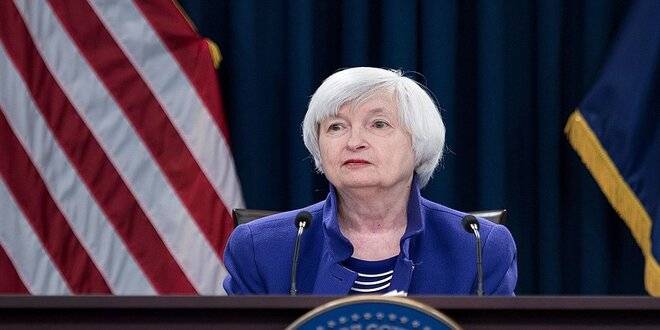Dollar pegged digital currencies are rising and that has been taken into notice by the U.S regulators. So they have put stablecoins under scrutiny.
On Monday, the Treasury Secretary Janet Yellen gathered a group of working Federal Agencies to talk about the future risks of stablecoins, which are digital currencies supported by the value of underlying assets, for example, US Dollars. It released a statement it has plans to issue recommendations in the upcoming months.
The group of working Federal agencies met just after the Federal Reserve Chair Jerome Powell told Congress that now is the right time to put stablecoins under scrutiny. According to him,
“If [stablecoins] is going to be a significant part of the payments universe, which we don’t think crypto assets will be, but stablecoins might be, then we need an appropriate regulatory framework, which frankly we don’t have.”
Stablecoins were formulated to be a bridge between digital currencies and fiat currencies, but now it has become a phenomenon in its own way, in reading the value over the previous year as the massive fluctuations in the digital currency market has pushed some investors to invest in safer assets while still working within the blockchain technology.
Along with that, they are also being highlighted at the moment when the governments are starting to shut down digital currencies, particularly with stablecoins attracting extra regulations from everyone from People’s Bank Of China to Mad Money’s Jim Cramer.
All this limelight and attention from the highest officials in the United States have raised an urgency for a better understanding and control over stablecoins. But the exact way to regulate stablecoins is still a big question. One that is just starting to witness opposing camps from the best approach.
Not All Stablecoins Are Equal
For payment company Circle, which functions on USDC, which is the second biggest stablecoin pegged by dollars, it is necessary for the regulators to not wedge all coins together.
According to the Chief Secretary Officer and the Head of Global Policy, Dante Disparte,
“I think the main message that we have to get out there and pierce through the headlines is that not all stablecoins are created equal.”
He proclaimed the commitments of Circle to releasing the information on a regular basis about its dollar dominated reserve’s composition, a practice that is presently not necessary by the law.
Among the stablecoins, the question of the reserve is important. Many, along with Circle, claim that their coins are backed one-to-one by the US dollars, which implies that the reserve kept by them is much bigger on hand than any average bank. So stablecoins under scrutiny are not required for all coins.
However, this exact stablecoin reserve breakdown has become a hot source of controversy.
In the most latest release, Circle asserted that 61% of its tokens are backed by “cash and cash equivalents,” with the remaining coming from the U.S Treasuries, certificate of deposits, municipal and corporate bonds, and commercial papers.
This compares to the leading stablecoin Tether which in May revealed that nearly half of its reserves are made up of commercial papers, a type of unsecured, short term debt that is related to bouts of fluctuations of its own.
Notably, Tether was the one who began sharing the composition of its reserves and attained the settlement with the Attorney General of New York Letitia James, who sued the entity for making unreal statements of what was backing the dollar reserve off their company.
According to Disparte, the present regulatory pressure is likely happening from the fact that,
“We live in a world in which there’s a $60 billion, very large offshore-dollar stablecoin in circulation today that isn’t abiding by anything quite close to those expectations or standards.”
According to the general counsel at Tether, Stuart Hoegner,
“Tether is the most transparent stablecoin. We were the first to disclose the composition of our reserves. We hold a strong, conservative, and liquid portfolio with an emphasis on safeguarding those reserves. Most importantly, we have never refused a redemption to a customer.
The company also asserted that it has already been tested by altering the market conditions.
“Stress-testing of Tether is not hypothetical.”
Hoegner further added,
“In March of 2020, bitcoin dropped by half in a couple of days. Just two months ago we had one of the worst days in bitcoin’s history, with prices falling by 30 percent in a few days in May. During those events, the Tether peg remained solid, all redemptions were honored, and even the price on exchanges remained stable.”
Stablecoins Under Scrutiny: Mastercard’s Reaction To That
On July 20, 2021, Mastercard declared a partnership with Paxos Trust Company, Evolve Bank & Trust, and Circle, who is the main issue behind that world’s second largest stablecoin USDC that has been created on the blockchain to enable an easy issue of debit and credit cards for the crypto firms. And Mastercard has done all this despite the condition of stablecoins under scrutiny.
Mastercard will specifically carry on a new capability for the settlement of transactions with the USDC so that the firms that are issuing the crypto cards can avoid the hindrances that occur while changing direct crypto to fiat currencies. Mastercard will start to accept USDC from the issuers of the cards and then alter the stablecoins fiat currency for settlement with the merchant in their native currency.
In a press release, Raj Dhamodharan who is the executive vice president of digital asset and blockchain products & partnerships at Mastercard asserted,
“Today not all crypto companies have the foundational infrastructure to convert cryptocurrency to traditional fiat currency, and we’re making it easier.”
He further added that,
“Through our engagement with Evolve, Paxos, Circle, and the larger digital assets community, Mastercard expects to deliver on our promise of consumer choice to provide options to people around the world on how and when to pay.”
Tezos ICO And Cryptocurrency
If you are creating a new blockchain platform, you might fund it with other digital currencies, and that’s what Tezos did when it planned to launch an ICO (Initial Coin Offerings). The Tezos ICO date for its latest decentralized blockchain system was on 1 July. And after 13 days of this digital asset crowd sale, Tezos ICO had successfully generated $230 million worth of digital currency. The Tezos IPO price was last closed at 65,627 BTC. The condition of stablecoins under scrutiny did not stop in this respect either.
Conclusion
There still remain crucial concerns regarding the fact that the stablecoins under scrutiny. Stablecoin industry giant Tether recently released the documents of its collaterals where it asserted that 61% of their reserve was backed by the commercial papers from undisclosed issuers.
 Crypto Venture News One stop Crypto Track Down
Crypto Venture News One stop Crypto Track Down 






